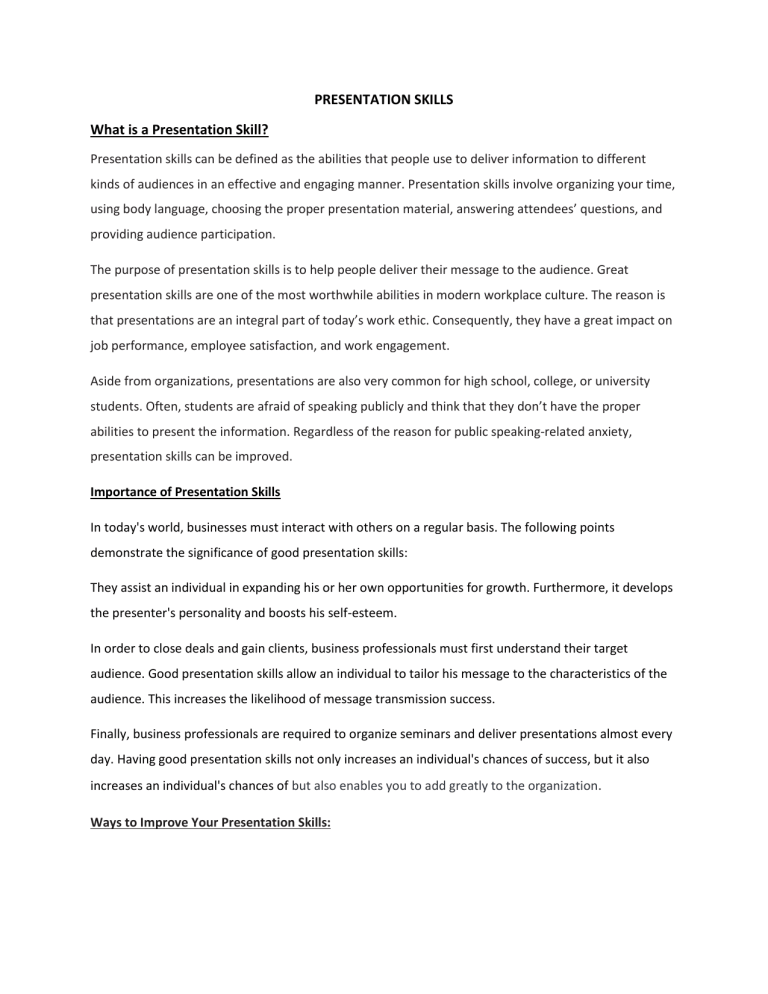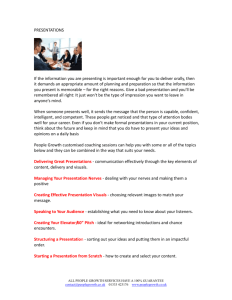
PRESENTATION SKILLS What is a Presentation Skill? Presentation skills can be defined as the abilities that people use to deliver information to different kinds of audiences in an effective and engaging manner. Presentation skills involve organizing your time, using body language, choosing the proper presentation material, answering attendees’ questions, and providing audience participation. The purpose of presentation skills is to help people deliver their message to the audience. Great presentation skills are one of the most worthwhile abilities in modern workplace culture. The reason is that presentations are an integral part of today’s work ethic. Consequently, they have a great impact on job performance, employee satisfaction, and work engagement. Aside from organizations, presentations are also very common for high school, college, or university students. Often, students are afraid of speaking publicly and think that they don’t have the proper abilities to present the information. Regardless of the reason for public speaking-related anxiety, presentation skills can be improved. Importance of Presentation Skills In today's world, businesses must interact with others on a regular basis. The following points demonstrate the significance of good presentation skills: They assist an individual in expanding his or her own opportunities for growth. Furthermore, it develops the presenter's personality and boosts his self-esteem. In order to close deals and gain clients, business professionals must first understand their target audience. Good presentation skills allow an individual to tailor his message to the characteristics of the audience. This increases the likelihood of message transmission success. Finally, business professionals are required to organize seminars and deliver presentations almost every day. Having good presentation skills not only increases an individual's chances of success, but it also increases an individual's chances of but also enables you to add greatly to the organization. Ways to Improve Your Presentation Skills: • Prepare Your Presentation in Advance. There are various methods of preparing for a presentation, and they’re all very similar to preparing for a job interview. Run lines with a mock audience or friend, like actors and actresses auditioning for movie and stage roles. Give yourself plenty of time to prepare for an upcoming presentation or speech, especially when you are less experienced. And, the last part of preparation—always be prepared with answers to follow-up questions once your presentation is over. • Practice. Naturally, you’ll want to rehearse your presentation multiple times. While it can be difficult for those with packed schedules to spare time to practice, it’s essential if you want to deliver a rousing presentation. If you really want to sound great, write out your speech rather than taking chances winging it – if you get nervous about speaking, a script is your best friend. Try to practice where you’ll be delivering your talk. Some acting strategists suggest rehearsing lines in various positions – standing up, sitting down, with arms open wide, on one leg, etc. The more you mix up your position and setting, the more comfortable you’ll feel with your speech. Do a practice run for a friend or colleague, or try recording your presentation and playing it back to evaluate which areas need improvement. Listening to recordings of your past talks can clue you in to bad habits you may be unaware of, as well as inspiring the age-old question: “Is that what I really sound like?” • Use Positive Visualization. Whether or not you’re a master, know that plenty of studies have proven the effectiveness of positive visualization. When we imagine a positive outcome to a scenario in our mind, it’s more likely to play out the way we envision. Instead of thinking “I’m going to be terrible out there” and visualizing yourself throwing up midpresentation, imagine yourself getting tons of laughs while presenting. Positive thoughts can be incredibly effective – give them a shot. • Use less text and more visuals in your presentation. If the presentation lacks color, images, and all sense of creativity while containing an over-abundance of text and long-form paragraphs they are horrible for two reasons: The first reason being that the minute you have words on the screen, your audience will direct their attention away from you to begin reading and completely tune you out. The second reason is if your presentation skills are poor, not only will your presentation be dull to listen to, but it will be unbelievably boring to look at as well. You’ll quickly find out how easy it is to lose most of the room’s attention when you create a lackluster presentation. If you feel lost attempting to design your slides into an exciting work of art, try using creative presentation templates. PowerPoint templates make it simple to produce something beautiful, and they can also make you feel like an accomplished designer after seeing the outcome, such as this business presentation for example. • Understand What You Should and Shouldn’t Do. On your first presentation, you’d be forgiven for having a coffee to clear the fog from your mind. If and when it increases any pre-PowerPoint jitters, you know never to drink coffee prior again. Same goes for the way you breathe, and the food you consume beforehand. You don’t need the added discomfort of a gassy stomach, so know what foods, if any, cause that for you. On the other hand, exercise, for most people, is a great way to relieve any built-up tension the night prior. As you practice, practice, practice, you’ll get signals from your environment, audience, and body as to what does and doesn’t work for you. • Maintain eye contact while presenting and smile. Maintaining eye contact with the audience during the presentation is especially vital for giving each of your listeners the sensation of being important and being personally addressed. This not only exudes self-assurance, but it also allows your audience to connect with you and your topic. It also makes you feel less jittery. Look for someone in the audience who appears to be truly engaged in the subject and is paying attention (for example, your lecturer). At the start of the presentation, make eye contact with this person. Allow your sight to roam over the crowd to address the other listeners as you begin to feel more calm and secure. Continue to redirect your look to the individual who drew your attention in the first place. Types of Presentation: ▪ Providing Information - This format encompasses anything from a team meeting that gives updates on a project or upcoming event to a demonstration that shows product functions. ▪ Teaching a Skill - Your company just installed a new system or implemented a new process that requires people to learn how to use the new tool and apply the process. ▪ Reporting Progress - As you integrate the new system into your daily routine, your boss wants to know how it’s working. You might schedule a divisional meeting or group off-site to share the progress. ▪ Selling a Product or Service - A briefing like this might include a recap of the product or service, next steps and action items, or a discussion of needs and improvements before the product is ready to sell. ▪ Making a Decision - It’s time for the annual holiday party and ideas are being tossed around the office. When giving your input on the location, make sure to share the must-haves and nice-tohaves for the event. When it’s time for the final decision, you can see how your idea stacks up to the other options. ▪ Solving a Problem - This could be in a panel setting or other meeting where the problem is identified, the facts of the problem are presented and a list of causes is generated. From here, you lay out the ideal outcome, present solutions and discuss your recommendation. Tips for professionalism while Presenting: ▪ Dress neatly. Pick something you feel good and comfortable in. ▪ Smile. ▪ Remember to breathe. ▪ Make eye contact with people in the room. ▪ Pay attention to your body language. ▪ Watch for unconscious mannerisms (e.g., fiddling with a pen or swaying). ▪ Take a breath or pause instead of saying filler words like ‘um’ or ‘like’. ▪ Pause before and after important ideas so that your audience can digest what you have said. ▪ Be aware of your audience and select a language that they will understand. ▪ If something unexpected happens, go with it. Only you know how it was supposed to go. Presentation Delivery Methods: 1. Extemporaneous presentations are those you deliver without any preparation, though you plan it beforehand. 2. Memorized presentations are those you learn by heart. Hard to get right, but compelling if it is! 3. Manuscript presentations are those you deliver from a pre-written script or notes. 4. Impromptu presentations are similar to extemporaneous presentations, but you decide on and deliver them on the spot. Overcoming nerves: • Presentation nerves can be positive - To do the best possible presentation, you need some energy, some ‘edge’. Totally nerveless performances can be flat. • Preparation is key - If you have prepared an interesting presentation with a clear structure and lots of examples, your anxiety will decrease. • Think positively - Your lecturer, seminar tutor and your peers all want you to do well. Afterwards, you will feel great! • Relaxation techniques - Everybody has their own way of controlling and channeling nerves. Use it. Presentations are a great way to practice a wide range of skills and to build general confidence of your audience. If you have problems with timing, take one lesson per term, building confidence bit by bit throughout the year. To help the audience grasp the aim of the discussion and keep them focused from the beginning to the end of the presentation, one must be properly organized. You will gain confidence and be more successful in the future if you can put together a basic and well-organized presentation. As a result, before beginning industrial training or a full-time work, one must understand the importance of presentation skills.
